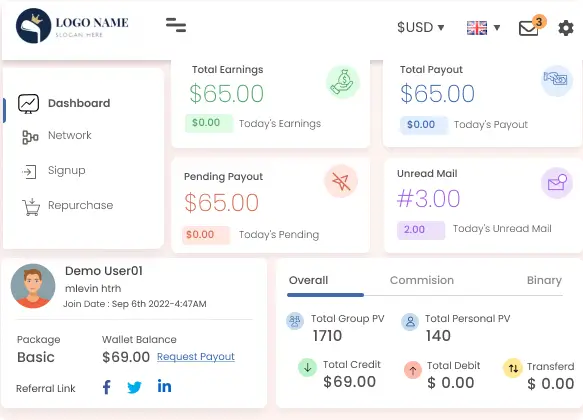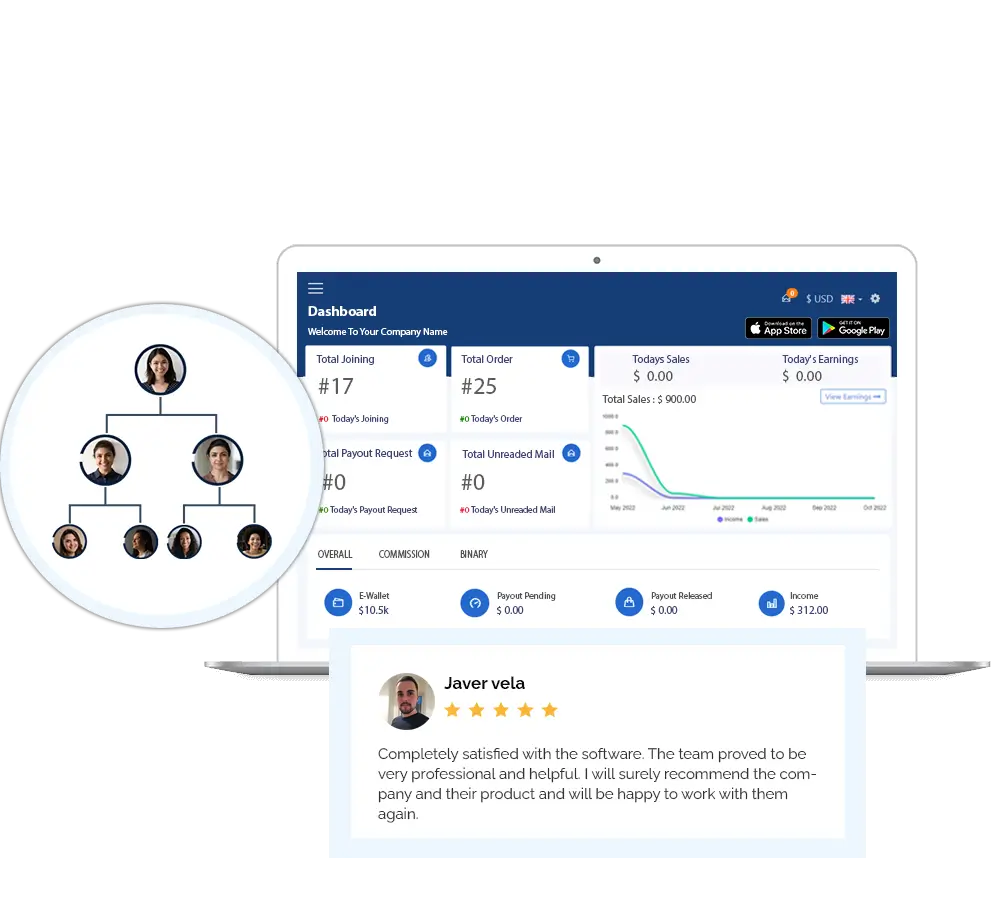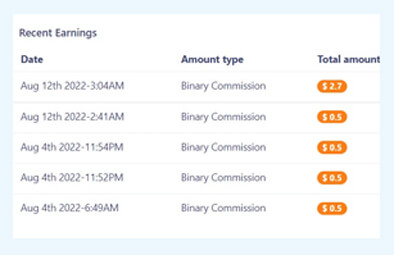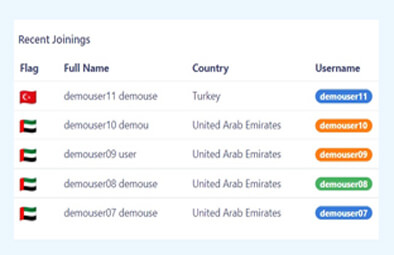Frequently Asked Questions
1. What is Binary MLM Software and how does it work?
Binary MLM software is a purpose-built system for managing multi-level marketing businesses that follow a binary structure, meaning every distributor can recruit two members and build a left and right leg. Unlike manual tracking or generic MLM tools, binary software actively manages the entire network by automating leg balancing, payout calculations, sponsor mapping, genealogy tracking, carry-forward logic, and commission distribution. It eliminates manual errors, ensures fair placement, and brings real-time clarity to network growth. The software also includes admin controls, distributor dashboards, spilling rules, compensation engines, reporting, and security layers to run a scalable MLM business without operational chaos. Think of it as the central nervous system of a binary network—giving you visibility, control, automation, and accuracy at every level of expansion.
2. How are commissions calculated in Binary MLM software?
Binary MLM software calculates commissions using automated logic based on pairing, carry-forward volumes, spillover, leg matching, sponsor bonuses, capping rules, and ROI conditions. Instead of manual spreadsheets, the software detects sales volume on both legs, identifies matching pairs, applies the payout formula you set, and processes commissions instantly. It also supports advanced logic like weak leg or strong leg preference, binary cycle rewards, customized payout caps, matching bonuses, and spill policies. Additionally, the system maintains compliance by enforcing payout limits, calculating deductions, and generating audit-ready records. This means distributors get paid faster and more accurately, while admins maintain control over profitability, fairness, and compensation integrity—all without human miscalculations or delays.
3. Can I fully customize my compensation and reward plan?
Yes, the software is built to support deep, code-free customization of binary compensation plans. You can define pairing bonus ratios, set cycle caps, activate or deactivate spillover, choose strong or weak leg payout priorities, structure ROI rules, assign matching bonuses, configure payout frequencies, and even combine binary with unilevel, matrix, or monoline models. Beyond that, it lets you implement custom reward journeys such as incentives, rank bonuses, milestone rewards, referral bonuses, and leadership rewards. This flexibility ensures your compensation plan aligns with your business goals, market behavior, and distributor needs—without restrictions. The platform evolves as your MLM evolves, letting you experiment with new payout logic without developer dependency.
4. Does the software support crypto payments and multiple payout methods?
Yes, the system supports both traditional and blockchain-based payment methods. You can enable multiple payout channels like bank transfer, wallet payouts, payment gateways, and cryptocurrency options such as Bitcoin, Ethereum, or custom tokens. The multi-wallet configuration allows you to separate commission wallets, reward wallets, purchase wallets, and paid bonus wallets for better streamlining and transparency. Transactions are secured through encrypted protocols, fraud prevention layers, and audit trails to maintain financial integrity. This level of flexibility helps you cater to global distributor networks with diverse payout preferences while keeping transactions fast, secure, and compliant.
5. Can I visualize and manage my entire binary network easily?
Yes. The software includes a visual genealogy tree and binary network visualization to give admins and distributors a full overview of team structure, leg strength, placement depth, growth metrics, and spill behavior. You can track joiners, sponsor mapping, carry-forward values, inactive legs, balanced cycles, weak and strong leg performance, and commission eligibility from a single interface. This visual clarity is crucial for strategic planning, faster decision-making, and placement optimization. Instead of guessing network health through reports, you see it in real time through an interactive tree that makes expansion logic transparent and actionable.
6. Is this scalable for large and fast-growing MLM networks?
Yes—scalability is one of the core strengths. The system is built to seamlessly handle everything from early-stage teams to enterprise-size networks with 100,000+ distributors. Performance stays stable even during peak activity like mass onboarding, payout cycles, bonus days, promotions, or contest periods. The backend infrastructure supports high-volume data loads, rapid commission processing, real-time dashboards, and cloud scalability. This means your business can expand aggressively without worrying about downtime, data crashes, slow payout processing, or software breakdowns.
7. Can I migrate my existing MLM data without losing information?
Yes, the platform supports end-to-end migration from your current MLM system—including genealogy data, payout history, commission cycles, wallet balances, distributor records, rank history, and sponsorship structure. The process is handled securely with zero data loss and minimal disruption. Migration includes data mapping, cleaning, validation, and deployment to avoid misalignment in your binary tree or payout history. You don’t start from scratch—your entire business moves as-is, but now onto a faster, safer, smarter infrastructure.
8. How secure and compliant is the software?
Security is built into every layer. The platform includes encrypted data storage, secure login protocols, role-based access controls, fraud monitoring, payout protection, activity logs, and tamper-safe transaction records. It also supports multi-country tax configuration, compliance adjustments, payout capping, and audit-ready commission trails. This ensures your MLM business stays legally compliant, financially protected, and resistant to data leaks, internal misuse, or payout manipulation. Distributors get a safer platform, and admins maintain total oversight without worrying about regulatory or operational risks.
9. What tools do distributors get to support their growth?
Distributors receive performance dashboards, downline visibility, goal tracking, sales monitoring, commission reports, wallet access, training modules, promotional assets, referral tools, and binary tracking features. They can monitor personal productivity and team activity without depending on admins. The self-serve interface helps them take smarter actions, track earnings, plan placements, share campaigns, and optimize leg growth independently. This not only increases efficiency but also improves distributor motivation, retention, and long-term success.
10. What kind of support is available after deployment?
You get live support from real experts—not bots or ticket-only responses. The support covers onboarding, troubleshooting, migration assistance, feature guidance, system optimization, and payout-related queries. Whether it’s payout cycles, configuration updates, distributor concerns, feature customizations, or technical issues, help is available in real time. This ensures uninterrupted business operations and faster issue resolution so your network never hits a roadblock due to software confusion or lack of guidance.































































